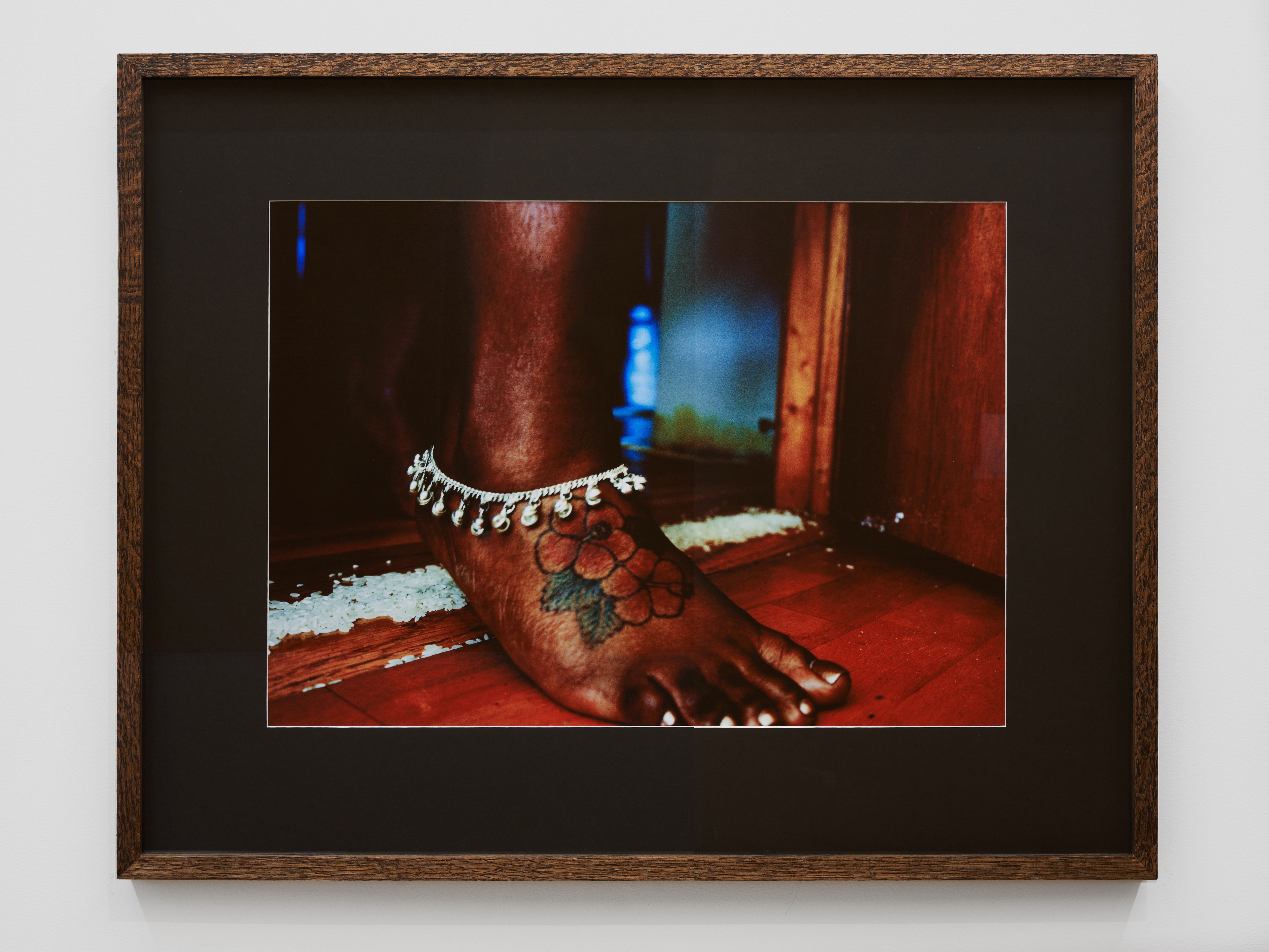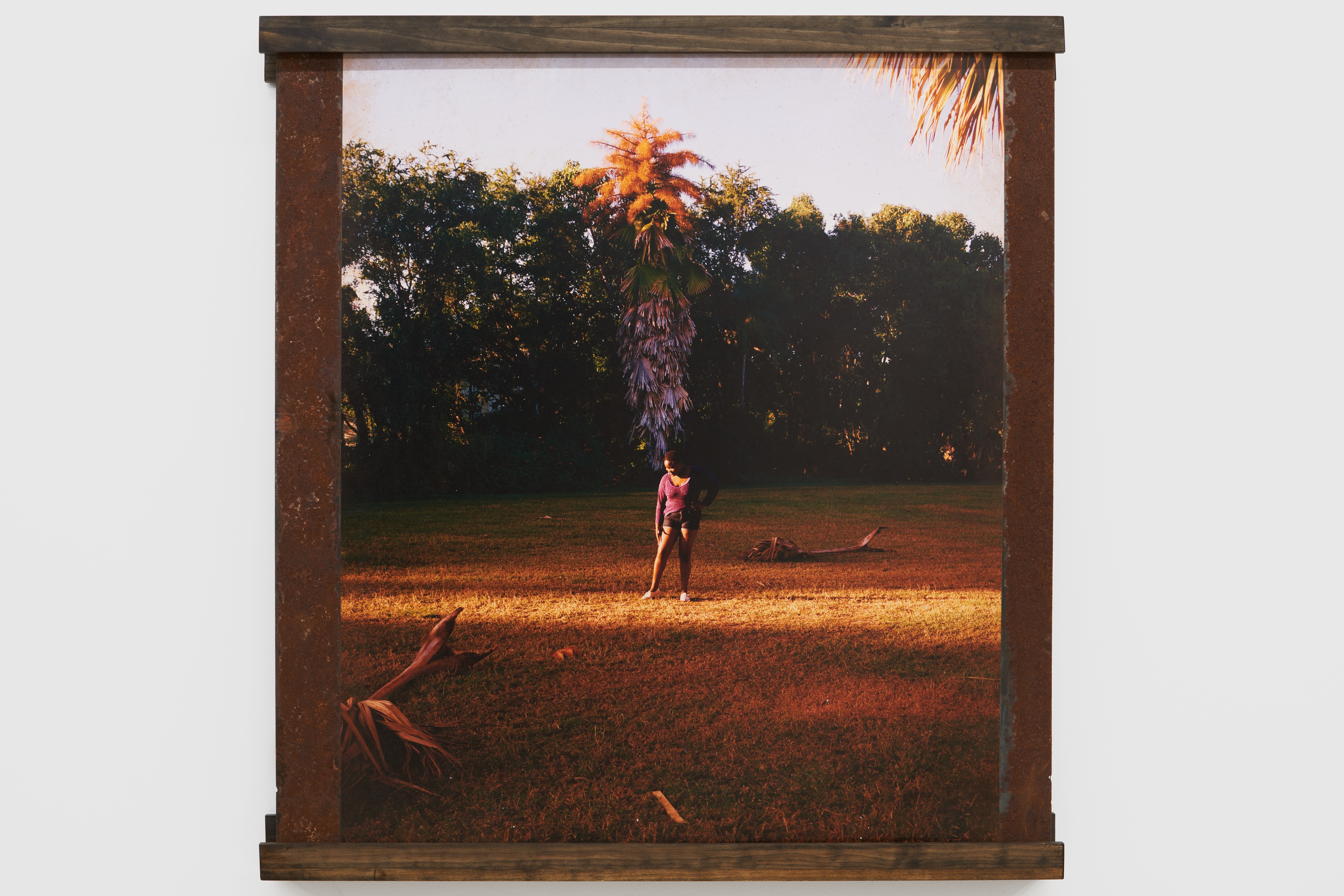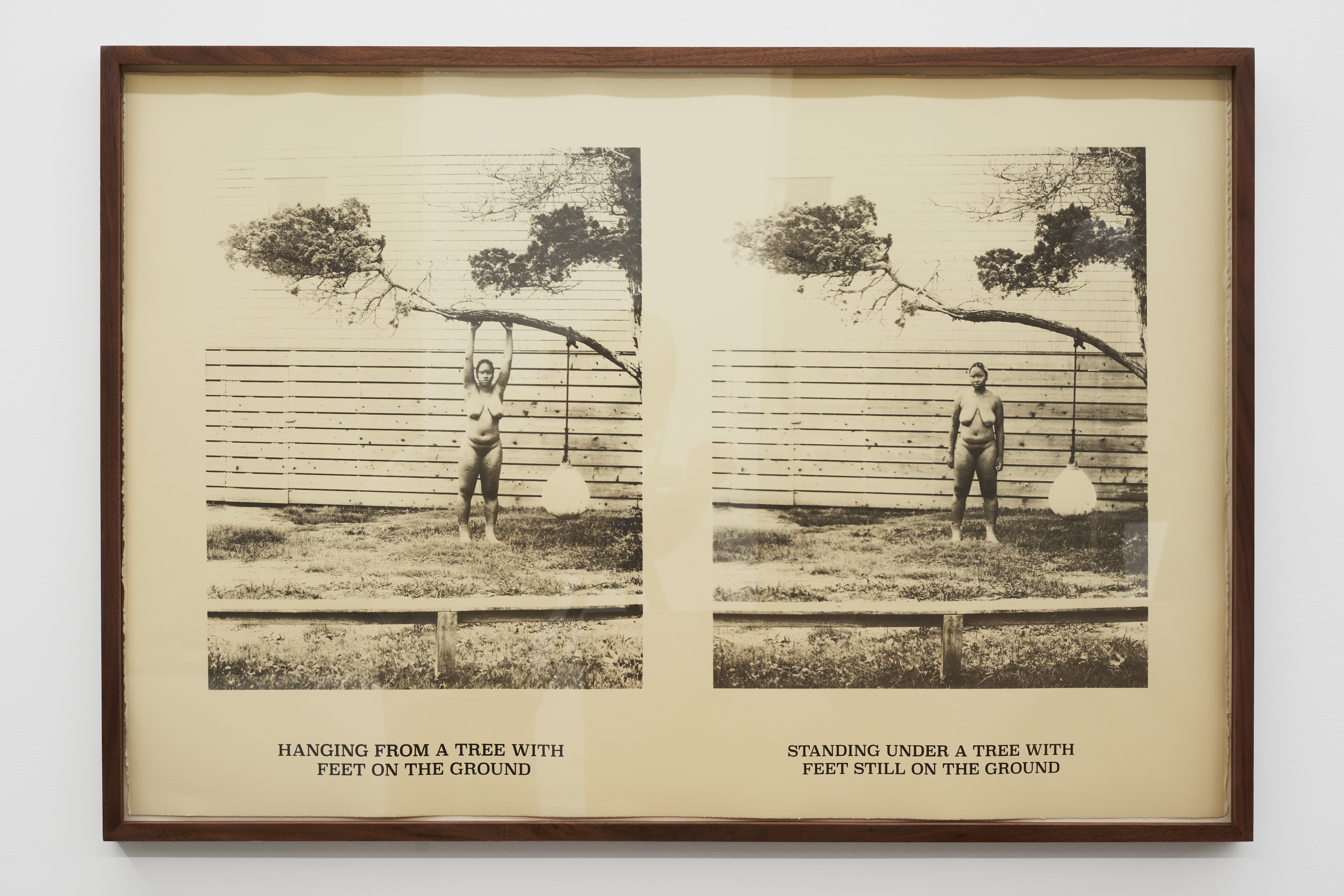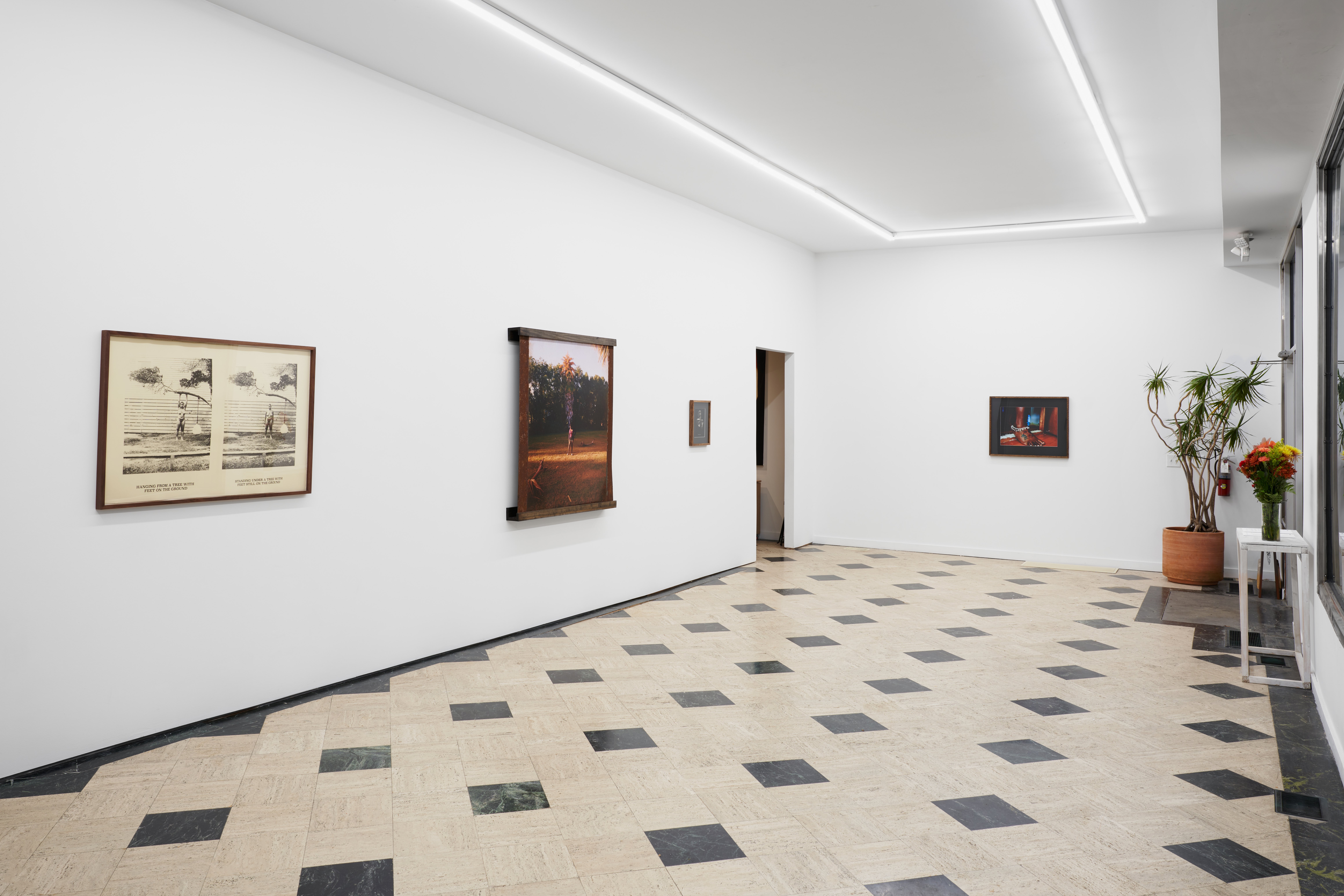

Installation view of Tangible Possibilities
Tangible Possibilities
Review
Nick Hartman
No Place Gallery is playing host to the duo of current MFA candidates, Kearra Amaya Gopee and Shala Miller, in a show curated by recent Columbus College of Art & Design alum, Reg Zehner. I would have walked past the gallery if not for the sole signage—a quaint, brown-painted fold-out sign in the sidewalk with haphazardly cut out “No Place” attached in school bus yellow. No Place Gallery itself is a small, unassuming gallery space made up of two main rooms—a front display room and a small installation space in the rear.
Acting as a visual signature, Gopee’s threshold (2015) is the first piece within Tangible Possibilities. In the work, an ankle bracelet clad tattooed foot crosses over a rice-lined doorway—a visual metaphor as an entry point. The lack of information about the piece leads to more of a mystery; the rice line and adornment feels ritualistic; it is drawing a metaphorical line about the intention behind the background of the image itself, leaning into a more open-ended interpretation. Per the gallery takeaway sheet, Gopee views themself as an anti-disciplinary artist with a research-based practice using lived experiences as a site of departure.
Adjacent to threshold, Shalla Miller’s Your Favorite Position (2022) immediately breaks the fourth wall by approaching the gaze of the viewer directly. “YOUR FAVORITE POSITION” is printed directly below a triangular portrayal of three bent-over faceless nude figures—it points the figure at the viewer and demands a conversation, or at least an internal dialogue. It is a vulnerable piece dealing straightforwardly with identity, cultural expectations, and gender sexualization. After years of being silenced, Miller states they are trying to “find their way into an understanding of themselves and their history,” causing this piece to feel even more traumatic and open. Besides adding rhythm and movement to the composition, the repetition of the figures emphasizes the position of the figure and feels like the artist is one of many, yet it does not come off as defeated or powerless. It’s intense and guttural in nature, but bold and dauntless in tone.
Miller’s Play (2020) is a horizontal pictorial diptych showing the artist once again nude under a weighted tree branch. Under the left image are the words: “HANGING FROM A TREE WITH FEET ON THE GROUND” while the words under the right image state “STANDING UNDER A TREE WITH FEET STILL ON THE GROUND”. The outside world has no effect on the artist’s levity, and the outside world is unaffected by their presence—even though they are baring everything, they are in a state of purgatory. The image feels wrought with interpersonal struggle. The artist’s face is solemn and on the verge of appearing miserable, as if coming to the realization that nothing can be done. The metaphor is painful, pulling me back to view the piece more than once.
Gopee’s threshold and Miller’s Brown Sugar (2019) both utilize tightly cropped imagery of body adornment as permanent visual affirmation—these are identification marks and identity symbols placing both individuals in the foreground. Brown Sugar is displayed in a beautifully simple glass floating frame, a clean aesthetic for a palatable discourse. The image depicts a tattoo stating “Brown Sugar” in cursive located on the artist’s breastbone, and the printing process resembles a copper plate intaglio print more than a photograph. This tattoo is a personal affirmation of someone who is trying to showcase self-appreciation and self-love. Miller is being vulnerable through their body, and it reads of emotional growth—a tonal shift from Play. It is hauntingly beautiful in its quiet definition, like yelling at the volume of a whisper.
Breaking up Miller’s showcase of three pieces within Tangible Possibilities is Gopee’s duo of Tutorials on Radiance (2019) and Tutorials on Radiance 2 (2019). Both works are images printed on metal framed by a raw rusted edge on the left and right of the image. The works are both presented on a polished wooden bracketed shelving on the top and bottom of the image plane. The wooden shelving encases the pieces while the rust is slowly breaking it down with corrosion. This juxtaposition between a sturdy exterior embrace and a deterioration coming from within intensifies the complexity of the images. The images themselves are figural and set in nature. Tutorials on Radiance shows a figure standing in a beam of sunlight, with a large palm tree centered in the background. Within the picture plane, the figure feels like a lasting memory. It is a moment caught in time with an expression of happiness, perhaps the end of a shared laugh with the photographer. Similarly to threshold, Tutorials on Radiance 2 depicts a figure at a doorway—an entrance from the outside world, possibly? Similarly to threshold, there is mystery behind the images themselves, but again the high level of presentation lifts them up from mere snapshots. The images depicted within themselves do not matter as much as the actual feeling they radiate.
Tangible Possibilities comes to a close with the 2022 video installation by Kearra, Pappyshow in the Dark Time, My Love. It is an intimate back and forth of sorts—a three channel looping video which showcases conversational issues between three individuals contemplating their past shared experiences. It is an intimate glimpse into reality, giving a visceral example of deeply felt pain being able to rise to the surface at a moment’s notice. In one powerful moment of dialogue, they discuss their overlaying feeling of anger over a broken cultural system while knowing they would be “demonized” if they publicly outcry the pain they feel internally—the lack of justice brings pain to their faces and the moment immediately brought me back to the figure’s face in Miller’s Play. Fire breathing interlaced with moments of public riot appears to be trance induced and yet fixed; it’s a visual moment which is intensified by the heavy bass, modified vocal screams, and repeated drums. The dialogue is closed captioned and repeated on three walls, echoing the importance of the text within the work in the previous room. This conversational relationship of the work throughout the show created a desire to revisit pieces more than once.
Unfortunately, technical difficulties prevented the subwoofers affixed to the ouroboros-etched metal bench to work, but one can visualize how one more level of visceral vibration would have enveloped the space even further—chain mail fastened to the seat, rattling whilst echoing the harmonizing bass projected above the viewer. The trance-like visuals intensify, and the space is transformed on another level. That being said, the use of the ouroboros iconography harkens back to an endless cycle, and also interplays with moments of dialogue in which violence by way of retaliation is discussed. Ultimately, it is agreed that an act of violence would be merely momentary vengeance and cyclical. This hurt and underlying anger is ever-present, and knowing this pain is unescapable it is a strong takeaway from Tangible Possibilities.
That said, galleries like No Place are exciting to visit in an art world dominated by performative acts to appease collectors— risks are taken, and rules can be more fluid. The lighting is minimal and clean, the tile floors feel like the space could have once been a bank, and the homemade, upcycled, painted table is in every independent/artist-run gallery I have ever been to. Yet, it has all the right vibe—it’s DIY punk rock with sophisticated taste. The minimal approach also leans the artwork into a more serious vibe—the walls are left bare to showcase the art, no names, titles, or item numbers to identify the work; only a small key on the takeaway sheet gives any outside information about each piece.
Even within the small space, Kearra Amaya Gopee and Shala Miller’s work are given room to breathe, but never feel isolated. The flow between the pieces feels conversational and intimate; artwork is not separated by grouping them by artist, and each piece flows back and forth in a way which leads to deeper readings in the space between the work itself. Melancholic, reflective, and sobering, the echoes speak loudly as you travel from piece to piece, as the whole is greater than the sum of its parts for this show.
While small in scope, Tangible Possibilities delivers an emotionally charged vision between two artists who demonstrate individually in vision, while also working in unison as a cohesive pairing; as if conversationally staring back at one another in the gallery space. These two artists confronting similar issues are highlighted by Reg Zehner’s curation. Zehner made intentional choices to highlight different aspects of the work; placement of each piece and the minimal amount of work in the space feels right, and the room between each piece is just as important—the show flows and communicates within itself and the dialogue is back and forth. At first glance, the show feels harmonious, immediately striking, and sophisticated, and that only gets reinforced once you view the exhibition in its entirety.

Kearra Amaya Gopee, Threshold (2015), digital print, 24” x 17.25”

Kearra Amaya Gopee, Tutorials on Radiance (2019), photograph on metal, 48 3/8” x 56”

Shala Miller, Play (2020), halftone silkscreen on Rives, 34” x 45”, edition of 3 + 2 AP

Installation view of Tangible Possibilities

Kearra Amaya Gopee, Pappyshow in the Dark Time, My Love (2022), 3-channel video, iron, Aluminum., Chain mail, wood, subwoofer, mixer, amplifier, and speakers.

Shala Miller, Your Favorite Position (2022), photo lithograph and silkscreen on rives, 11” x 8.5”
Tangible Possibilities was on view at No Place Gallery through December 10, 2022.
-
2.25.23
Nick Hartman [he/him] (BFA, MA) is a mixed media artist and professional art preparator based out of Louisville, KY.
-
2.25.23
Nick Hartman [he/him] (BFA, MA) is a mixed media artist and professional art preparator based out of Louisville, KY.







